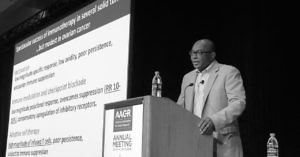Targeting TGF-β and the tumour microenvironment
We know that not every patient responds to checkpoint therapy and some may respond but then stop responding, so what can we learn about the tumour microenvironment in order to fix it?
To do this may well require retrospective analyses of the existing trials in order to learn what happened and figure out an improved design of the next wave of clinical trials with rationally based combinations (as opposed to randomly testing two molecules simply because that’s what a company has in its pipeline).
The other thing to consider is that while some people might have a high level of a particular marker or inhibitory factor up front, others may see rise on treatment as an adaptive response to immunotherapy. Those two situations may well require quite different approaches or regimens to address, making things much more complicated than originally thought.

Dr Kunle Odunsi (Roswell Park) at #AACR18
One topic that caught our attention in the run-up to AACR and subsequently during the meeting was a cytokine called transforming growth factor beta (TGF-β). We have covered IL–2, IL–6 and IL–15 developments quite extensively on BSB, but what of TGF-β?
As such, we decided to investigate this little known target further and explore the concept from different perspectives in both academia and industry.
Today, we begin this latest mini-series with a thought leader interview from an academic institution who is researching a novel approach to combination therapy based on TGF-β – here’s what he had to say about the topic…
To learn more and get a heads up on our latest thought leader interviews and oncology insights, subscribers can log-in or you can click to gain access to BSB Premium Content.
This content is restricted to subscribers